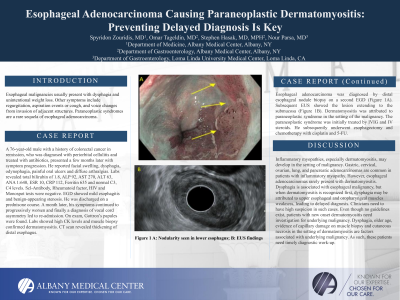Back


Poster Session A - Sunday Afternoon
Category: Esophagus
A0221 - Esophageal Adenocarcinoma Causing Paraneoplastic Dermatomyositis: Preventing Delayed Diagnosis Is Key
Sunday, October 23, 2022
5:00 PM – 7:00 PM ET
Location: Crown Ballroom

Has Audio

Spyridon Zouridis, MD
Albany Medical Center
Albany, NY
Presenting Author(s)
Spyridon Zouridis, MD1, Omar Tageldin, MD1, Stephen Hasak, MD, MPH1, Nour Parsa, MD2
1Albany Medical Center, Albany, NY; 2Loma Linda University Medical Center, Loma Linda, CA
Introduction: Esophageal malignancies usually present with dysphagia and unintentional weight loss. Other symptoms include regurgitation, aspiration events or cough, and voice changes from invasion of adjacent structures. Paraneoplastic syndromes are a rare sequela of esophageal adenocarcinoma.
Case Description/Methods: A 76-year-old male with a history of colorectal cancer in remission, who was diagnosed with periorbital cellulitis and treated with antibiotics, presented a few months later with symptom progression. He reported facial swelling, dysphagia, odynophagia, painful oral ulcers and diffuse arthralgias. Labs revealed total bilirubin of 1.8, ALP 92, AST 270, ALT 63, ANA 1:640, ESR 10, CRP 112, Ferritin 635 and normal C3, C4 levels. Scl-Antibody, Rheumatoid factor, HIV and Monospot tests were negative. EGD showed mild esophagitis and benign-appearing stenosis. He was discharged on a prednisone course. A month later, his symptoms continued to progressively worsen and finally a diagnosis of vocal cord asymmetry led to re-admission. On exam, Gottron’s papules were found. Labs showed high CK levels and muscle biopsy confirmed dermatomyositis. CT scan revealed thickening of distal esophagus. Esophageal adenocarcinoma was diagnosed by distal esophageal nodule biopsy on a second EGD (Figure 1A). Subsequent EUS showed the lesion extending to the submucosa (Figure 1B). Dermatomyositis was attributed to paraneoplastic syndrome in the setting of the malignancy. The paraneoplastic syndrome was initially treated by IVIG and IV steroids. He subsequently underwent esophagectomy and chemotherapy with cisplatin and 5-FU.
Discussion: Inflammatory myopathies, especially dermatomyositis, may develop in the setting of malignancy. Gastric, cervical, ovarian, lung, and pancreatic adenocarcinomas are common in patients with inflammatory myopathy. However, esophageal adenocarcinomas rarely present with dermatomyositis. Dysphagia is associated with esophageal malignancy, but when dermatomyositis is recognized first, dysphagia may be attributed to upper esophageal and oropharyngeal muscles weakness, leading to delayed diagnosis. Clinicians need to have high suspicion in such cases. Even though no guidelines exist, patients with new onset dermatomyositis need investigation for underlying malignancy. Dysphagia, older age, evidence of capillary damage on muscle biopsy and cutaneous necrosis in the setting of dermatomyositis are factors associated with underlying malignancy. As such, these patients need timely diagnostic work-up.

Disclosures:
Spyridon Zouridis, MD1, Omar Tageldin, MD1, Stephen Hasak, MD, MPH1, Nour Parsa, MD2. A0221 - Esophageal Adenocarcinoma Causing Paraneoplastic Dermatomyositis: Preventing Delayed Diagnosis Is Key, ACG 2022 Annual Scientific Meeting Abstracts. Charlotte, NC: American College of Gastroenterology.
1Albany Medical Center, Albany, NY; 2Loma Linda University Medical Center, Loma Linda, CA
Introduction: Esophageal malignancies usually present with dysphagia and unintentional weight loss. Other symptoms include regurgitation, aspiration events or cough, and voice changes from invasion of adjacent structures. Paraneoplastic syndromes are a rare sequela of esophageal adenocarcinoma.
Case Description/Methods: A 76-year-old male with a history of colorectal cancer in remission, who was diagnosed with periorbital cellulitis and treated with antibiotics, presented a few months later with symptom progression. He reported facial swelling, dysphagia, odynophagia, painful oral ulcers and diffuse arthralgias. Labs revealed total bilirubin of 1.8, ALP 92, AST 270, ALT 63, ANA 1:640, ESR 10, CRP 112, Ferritin 635 and normal C3, C4 levels. Scl-Antibody, Rheumatoid factor, HIV and Monospot tests were negative. EGD showed mild esophagitis and benign-appearing stenosis. He was discharged on a prednisone course. A month later, his symptoms continued to progressively worsen and finally a diagnosis of vocal cord asymmetry led to re-admission. On exam, Gottron’s papules were found. Labs showed high CK levels and muscle biopsy confirmed dermatomyositis. CT scan revealed thickening of distal esophagus. Esophageal adenocarcinoma was diagnosed by distal esophageal nodule biopsy on a second EGD (Figure 1A). Subsequent EUS showed the lesion extending to the submucosa (Figure 1B). Dermatomyositis was attributed to paraneoplastic syndrome in the setting of the malignancy. The paraneoplastic syndrome was initially treated by IVIG and IV steroids. He subsequently underwent esophagectomy and chemotherapy with cisplatin and 5-FU.
Discussion: Inflammatory myopathies, especially dermatomyositis, may develop in the setting of malignancy. Gastric, cervical, ovarian, lung, and pancreatic adenocarcinomas are common in patients with inflammatory myopathy. However, esophageal adenocarcinomas rarely present with dermatomyositis. Dysphagia is associated with esophageal malignancy, but when dermatomyositis is recognized first, dysphagia may be attributed to upper esophageal and oropharyngeal muscles weakness, leading to delayed diagnosis. Clinicians need to have high suspicion in such cases. Even though no guidelines exist, patients with new onset dermatomyositis need investigation for underlying malignancy. Dysphagia, older age, evidence of capillary damage on muscle biopsy and cutaneous necrosis in the setting of dermatomyositis are factors associated with underlying malignancy. As such, these patients need timely diagnostic work-up.

Figure: Figure 1 A: Nodularity seen in lower esophagus; B: EUS findings
Disclosures:
Spyridon Zouridis indicated no relevant financial relationships.
Omar Tageldin indicated no relevant financial relationships.
Stephen Hasak indicated no relevant financial relationships.
Nour Parsa indicated no relevant financial relationships.
Spyridon Zouridis, MD1, Omar Tageldin, MD1, Stephen Hasak, MD, MPH1, Nour Parsa, MD2. A0221 - Esophageal Adenocarcinoma Causing Paraneoplastic Dermatomyositis: Preventing Delayed Diagnosis Is Key, ACG 2022 Annual Scientific Meeting Abstracts. Charlotte, NC: American College of Gastroenterology.
